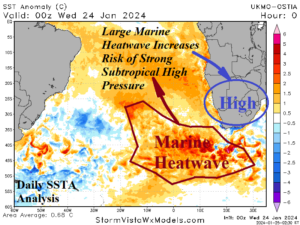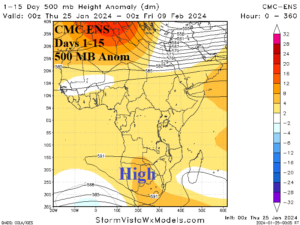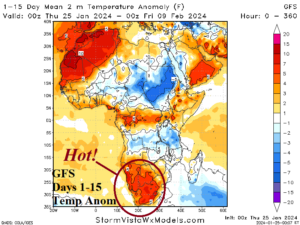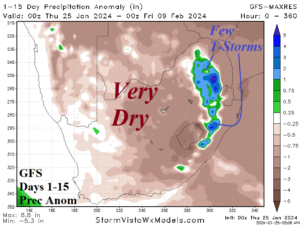Inaugural Year-2 Ahead Climate Outlook for North America
01/24/2024, 4:24 am ESTExcessive Heat Argentina, Hot Pattern Australia, Heavy Precipitation Returns to Europe, China chill.
01/28/2024, 1:16 pm ESTDiscussion: Characteristic of climate change is the evolution of marine heatwaves (MHW) as part of the warming of the global ocean surface in recent decades, particularly the last 10-15 years. MHW’s are not new but more frequent and cover larger areas of the ocean frequently lasting longer than several months and have impacts on the regional climate. Climate Impact Company follows MHW’s closely and their potential atmospheric impact. A recent MHW forming southwest of Africa is intensifying (Fig. 1). There is a tendency for subtropical high pressure ridging to strengthen across or nearby these large areas of warming ocean water. Today’s CMC ENS 15-day 500 MB anomaly forecast projects an amplified subtropical high-pressure ridge across South Africa (Fig. 2). The sensible weather is hot (maximum temperatures >100F) across Southwest Africa (Fig. 3) with very little rainfall (Fig. 4). Although positive Indian Ocean dipole (+IOD) is weakening, warm sea surface temperature anomalies (SSTA) linger in the western Indian Ocean tropics. The warm SSTA increases convective rain risk in East Tropical Africa. To compensate for the convection, an area of subsidence (dry climate) is generated over South Africa. The MHW and warm SSTA in the western tropical Indian Ocean combine to produce a climate pattern likely to cause a significant drought in South Africa.




Fig. 1-4: Marine heatwave is identified southwest of Africa and is well-correlated to short-term high-pressure across South Africa and the attendant hot and dry sensible weather.
